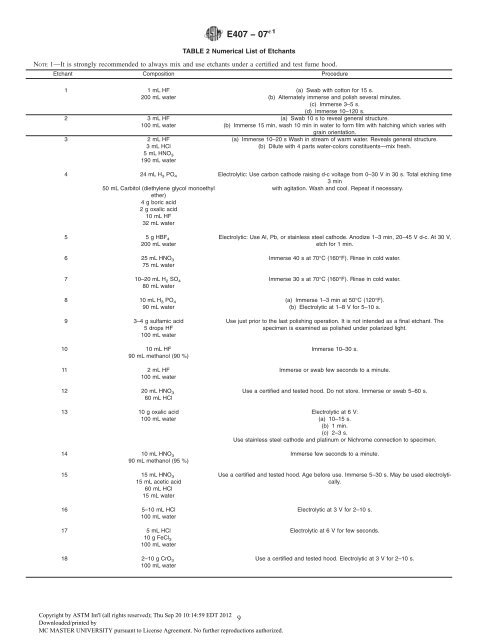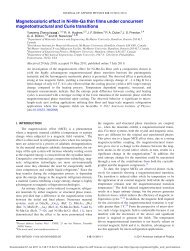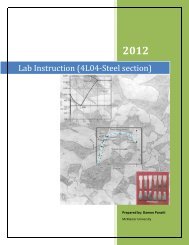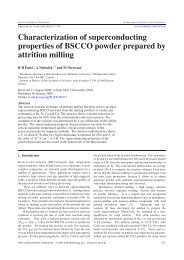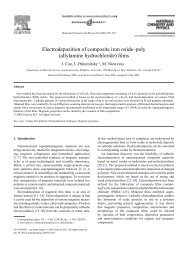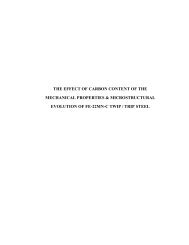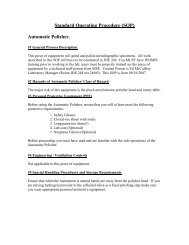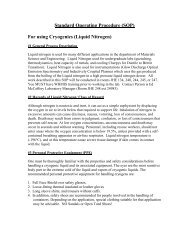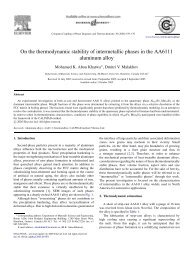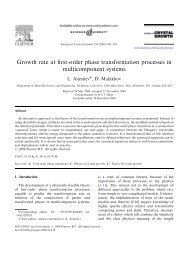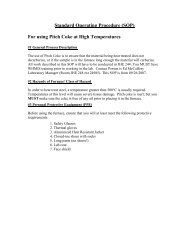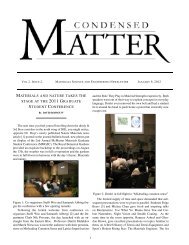E407-07 Microetching Metals and Alloys.pdf - McMaster Department ...
E407-07 Microetching Metals and Alloys.pdf - McMaster Department ...
E407-07 Microetching Metals and Alloys.pdf - McMaster Department ...
You also want an ePaper? Increase the reach of your titles
YUMPU automatically turns print PDFs into web optimized ePapers that Google loves.
TABLE 2 Numerical List of Etchants<br />
NOTE 1—It is strongly recommended to always mix <strong>and</strong> use etchants under a certified <strong>and</strong> test fume hood.<br />
Etchant Composition Procedure<br />
1 1 mL HF (a) Swab with cotton for 15 s.<br />
200 mL water (b) Alternately immerse <strong>and</strong> polish several minutes.<br />
(c) Immerse 3–5 s.<br />
(d) Immerse 10–120 s.<br />
2 3 mL HF (a) Swab 10 s to reveal general structure.<br />
100 mL water (b) Immerse 15 min, wash 10 min in water to form film with hatching which varies with<br />
grain orientation.<br />
3 2 mL HF (a) Immerse 10–20 s Wash in stream of warm water. Reveals general structure.<br />
3 mL HCl (b) Dilute with 4 parts water-colors constituents—mix fresh.<br />
5 mL HNO 3<br />
190 mL water<br />
4 24 mL H3PO4 Electrolytic: Use carbon cathode raising d-c voltage from 0–30 V in 30 s. Total etching time<br />
3min<br />
50 mL Carbitol (diethylene glycol monoethyl<br />
ether)<br />
4 g boric acid<br />
2 g oxalic acid<br />
10 mL HF<br />
32 mL water<br />
with agitation. Wash <strong>and</strong> cool. Repeat if necessary.<br />
5 5 g HBF 4<br />
200 mL water<br />
6 25 mL HNO 3<br />
75 mL water<br />
7 10–20 mL H 2 SO 4<br />
80 mL water<br />
Electrolytic: Use Al, Pb, or stainless steel cathode. Anodize 1–3 min, 20–45 V d-c. At 30 V,<br />
etch for 1 min.<br />
Immerse 40 s at 70°C (160°F). Rinse in cold water.<br />
Immerse 30 s at 70°C (160°F). Rinse in cold water.<br />
8 10 mL H 3 PO 4 (a) Immerse 1–3 min at 50°C (120°F).<br />
90 mL water (b) Electrolytic at 1–8 V for 5–10 s.<br />
9 3–4 g sulfamic acid<br />
5 drops HF<br />
100 mL water<br />
10 10 mL HF<br />
90 mL methanol (90 %)<br />
11 2 mL HF<br />
100 mL water<br />
12 20 mL HNO 3<br />
60 mL HCl<br />
13 10 g oxalic acid<br />
100 mL water<br />
14 10 mL HNO 3<br />
90 mL methanol (95 %)<br />
15 15 mL HNO 3<br />
15 mL acetic acid<br />
60 mL HCl<br />
15 mL water<br />
16 5–10 mL HCl<br />
100 mL water<br />
17 5 mL HCl<br />
10 g FeCl 3<br />
100 mL water<br />
18 2–10 g CrO 3<br />
100 mL water<br />
<strong>E4<strong>07</strong></strong> − <strong>07</strong> ´1<br />
Copyright by ASTM Int'l (all rights reserved); Thu Sep 20 10:14:59 EDT 2012<br />
9<br />
Downloaded/printed by<br />
MC MASTER UNIVERSITY pursuant to License Agreement. No further reproductions authorized.<br />
Use just prior to the last polishing operation. It is not intended as a final etchant. The<br />
specimen is examined as polished under polarized light.<br />
Immerse 10–30 s.<br />
Immerse or swab few seconds to a minute.<br />
Use a certified <strong>and</strong> tested hood. Do not store. Immerse or swab 5–60 s.<br />
Electrolytic at 6 V:<br />
(a) 10–15 s.<br />
(b) 1 min.<br />
(c) 2–3 s.<br />
Use stainless steel cathode <strong>and</strong> platinum or Nichrome connection to specimen.<br />
Immerse few seconds to a minute.<br />
Use a certified <strong>and</strong> tested hood. Age before use. Immerse 5–30 s. May be used electrolytically.<br />
Electrolytic at 3 V for 2–10 s.<br />
Electrolytic at 6 V for few seconds.<br />
Use a certified <strong>and</strong> tested hood. Electrolytic at 3 V for 2–10 s.


